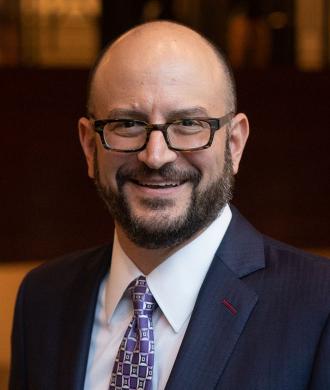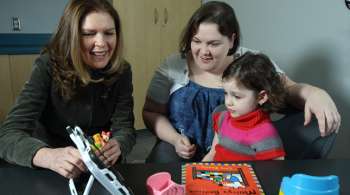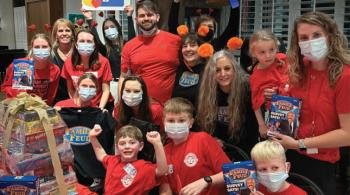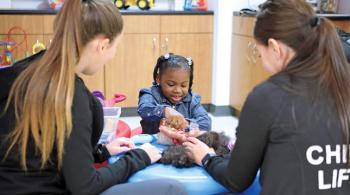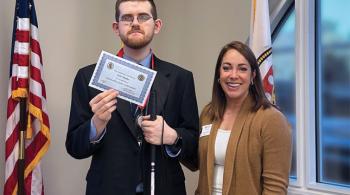There are over 7000 identified rare diseases that impact over 300 million people worldwide. And a disproportionate number of those rare diseases affect the developing brain and nervous system. Having any given rare disease is indeed rare. But having a rare disease is, in fact common. February, is rare disease awareness month and the last day of February is recognized internationally as Rare Disease Day. For this month’s episode, Dr. Brad Schlaggar, pediatric neurologist, and president and CEO of Kennedy Krieger Institute is joined by Dr. Anne Comi, a pediatric neurologist, to discuss a specific rare disease and some potentially very promising progress in its treatment. Additionally, we will hear from Megan Lewis, mother of Tucker, who shares some insights of their journey with a rare disease.
Learn More About Kennedy Krieger Faculty & Staff Members Featured in This Episode
Learn More About Kennedy Krieger Faculty & Staff Members Featured in This Episode
View Episode Transcription
Dr. Brad Schlaggar (BS): Welcome to Your Child's Brain, a podcast series produced by Kennedy Krieger Institute with assistance from WYPR. I'm Dr. Brad Schlaggar, pediatric neurologist and President and CEO of Kennedy Krieger Institute. As emphasized previously on this podcast, there are over 7,000 identified rare diseases that impact over 300 million people worldwide. A disproportionate number of those rare diseases affect the developing brain and nervous system. Having any given rare disease is indeed rare, but having a rare disease is in fact common. You may know that this month, February, is Rare Disease Awareness month, and the last day of February is recognized internationally as Rare Disease Day. How did that come about? In 2008, the European Organization for Rare Diseases declared February 29th, which is of course the rarest day on the calendar to be Rare Disease Day. In short order, hundreds of countries around the world adopted the last day of February as an annual recognition of the impact of rare diseases on the lives of individuals, families, and communities. For this month's episode, we're going to be focusing on a specific rare disease and some potentially very promising progress in its treatment. Sturge-Weber syndrome, which affects around one in 50,000 people, is a genetic neurovascular disorder that is associated with a characteristic, so called port wine birthmark involving the forehead and/or eyelids, and has abnormal blood vessels supplying the surface of the brain. The most common clinical problems for patients with Sturge-Weber syndrome are seizures and epilepsy, intellectual disability, stroke, and ophthalmological problems such as glaucoma. Standard treatment for this and the vast majority of rare diseases is strictly symptomatic, meaning we treat the symptoms after they emerge. Of course, a major objective for treatment is to discover cures, or if cure is not tenable, then treatments that can prevent symptoms from ever emerging. Now, it's my pleasure to welcome to the podcast, my exceptional colleague from Kennedy Krieger Institute, Dr. Anne Comi, an international leader in Sturge-Weber syndrome. Dr. Comi, a pediatric neurologist and physician scientist, is the director of the Hunter Nelson Sturge-Weber Center at Kennedy Krieger Institute. She's also a professor of neurology and pediatrics at the Johns Hopkins University School of Medicine. Just over a decade ago, she co-led a team of scientists from Kennedy Krieger Institute, Johns Hopkins Medicine, Duke University, and the Medical College of Wisconsin in the discovery of the gene that when mutated causes Sturge-Weber syndrome. Last month, Dr. Comi and colleagues published a very promising study indicating that treating patients with Sturge-Weber syndrome before neurological symptoms emerge may indeed delay or prevent the emergence of those symptoms. It is also my pleasure to welcome Ms. Megan Lewis. Ms. Lewis is the mother of Tucker. Tucker is a 4.5 year old who has Sturge-Weber syndrome and has been a patient at Kennedy Krieger Sturge-Weber program since he was six months old. Tucker and his family live in Georgia. Welcome Anne and Megan. Anne, let's start with you. I made some comments at the beginning about Sturge-Weber syndrome, but let's go back and define it. What is Sturge-Weber syndrome? What are the signs and symptoms? Let's go a bit deeper.
Dr. Anne Comi (AC): Sturge-Weber syndrome is a condition where there are abnormal blood vessels in the brain, the skin, and the eye. The children are born with this birth mark called a port-wine birthmark, which is pink or red in color because they are abnormal dilated blood vessels there. Similarly, there are abnormal dilated vessels in the eye which can cause glaucoma and abnormal malformed blood vessels in the brain that result in these neurological and developmental issues including seizures and stroke.
BS: Do all children with Sturge-Weber syndrome have a port-wine birthmark?
AC: Most children with Sturge-Weber syndrome do have a port-wine birthmark. About 90% do. However, a small percentage don't have a birthmark. They only have brain involvement. They present typically later with seizures, focal seizures, and they're picked up on imaging. But most children do in fact have a port-wine birthmark that they're born with. This is an indicator to us that we should be concerned about the possibility of Sturge-Weber syndrome.
BS: Does the location of that birthmark have any clinical significance, how the child is going to do clinically?
AC: It does. One in 300 children are born with a port-wine birthmark somewhere in the body. The head and neck area is the most common area of involvement. When the port-wine birthmark is on the forehead, the temple area, and the eyelids, any of those areas, then they have this increased risk of admiral blood vessels in the brain or the eye which we call Sturge-Weber syndrome.
BS: What is the overall risk for a child having developmental delay or some form of cognitive impairment in the setting of Sturge-Weber?
AC: About 20-25% of infants who are born with a port-wine birthmark have brain involvement with Sturge-Weber syndrome. If they have Sturge-Weber syndrome brain involvement, then the majority of them have some degree of learning difficulties, or attention issues, or developmental delays, or cognitive impairments. About a third overall have actual cognitive impairment that significantly can impair their quality of life and their developmental outcome.
BS: I mentioned earlier that you're a pediatric neurologist and a physician scientist. We're going to talk a bit about the scientist piece, the research that you've been doing over your career focused on Sturge-Weber. But let's talk more about the clinical aspects. You see patients in your clinic with Sturge-Weber, how is it typically treated?
AC: The standard treatment, the typical treatment for Sturge-Weber syndrome is to treat the seizures when they happen. The problem with this is that the onset of seizures, particularly when it's early in the first couple of years of life, can be very severe. The seizures are frequently prolonged, difficult to control. Because seizures in Sturge-Weber syndrome cause further impairments, further decreases in blood flow to the brain, the seizures and the abnormal blood flow in the brain interact to result in brain injury in many of these children. The onset of these seizures early in life can result in these children being started on multiple medications all at once to try to control those seizures. That too can cause lots of side effects and developmental issues for these children. The goal, pretty much from the beginning has been to figure out how do we better diagnose these children early, pick them up early, diagnose the brain involvement, and then figure out how best to pre-symptomatically treat them to prevent that brain injury.
BS: That's a great segue to really the next topic which gets at what you've been working on to understand the causes of Sturge-Weber syndrome and therefore how to identify it as early as possible. You've really spent your career focused on this, could you tell us some of what you've learned about how the genetic basis of Sturge-Weber syndrome has been identified?
AC: Several years ago, collaborating with others, we found that there is a mutation, a change in the genetic code, in a gene called gene Q, which means that it's not inherited, which was really important for parents and families to know. It happens after the fetus begins to develop and it only affects this area, the forehead, the skin, brain and eye, that area of the body. Therefore, I've seen multiple identical twins who one twin is affected and the other is not. It was really important that we determine this underlying basis several years ago because it's given us key insights into the pathways within the cells, within the blood vessels that are impaired and changed in Sturge-Weber syndrome. The understanding, the genetic basis, the mutation that causes Sturge-Weber syndrome has been really important because it has enabled us to investigate the pathways that are affected in the abnormal cells. It's enabled us to look at and develop new models in cells and in animals in the lab and also it's given us new insights into new targets, potentially new drugs and treatment that we might use to treat Sturge-Weber syndrome or even some day prevent the progression by actually targeting the gene itself.
BS: You made the point a moment ago that this is a genetic disorder. You've identified the gene that when mutated causes Sturge-Weber syndrome, but also that it's not inherited, and you said it's a somatic mutation. Listeners may not be familiar with how something could be genetic but not inherited. Maybe you could unpack that a bit.
AC: A somatic mosaic mutation is one that happens in the fetus after it begins to develop. You can have two identical twins, and one is affected and the other is not. We actually had to study tissue from affected areas, the birth mark for example, and unaffected tissue from the same individuals and compare those two genetic codes to find the change that causes Sturge-Weber syndrome. What that means is that currently, one cannot have a blood test for example to diagnose the underlying basis of Sturge-Weber syndrome, it's necessary to actually obtain a piece of skin tissue or brain tissue to actually make the underlining diagnosis. Perhaps that will change some day, but currently that's the case.
BS: One of the principles in the treatment of neuro developmental disorders is that early diagnosis and early intervention is key for optimizing outcomes. For Sturge-Weber syndrome, specifically, as we have mentioned, you are the co principal investigator and senior author, along with colleagues from Kennedy Krieger, Johns Hopkins Medicine, Boston Children's Hospital, on a really exciting research study just published last month. Could you tell us about this study? What was it that you did? What did you discover? I think you'll get to this, but also describe what presymptomatic treatment in Sturge-Weber syndrome involves.
AC: The study that you're referring to combined the data from our experience here at the Kennedy Krieger Institute and Boston Children's in providing presymptomatic treatment to babies who were diagnosed before their seizure started. Comparing the age of their seizure onset two similar children also seen at the two centers who were not presymptomatically treated. That's because the age of seizure onset is one of the few prognostic factors that we have that has been shown in many studies to predict epilepsy severity later in life, cognitive function later in life, neurologic status. The hypothesis was that if we could prevent the early seizures that are associated with brain injury and stroke, that we would be able to prevent the early seizures and thus improve outcome. Our data was from 92 babies with Sturge-Weber syndrome, 32 of whom received presymptomatic treatment compared to 60 children who did not. The severity of brain involvement with Sturge-Weber syndrome was actually more. There were more children who had both sides of the brain affected who were presymptomatically treated as compared to those who were not, and they were actually seen sooner. It's not that they just were already pretty close to two years of age. But the bottom line is that the presymptomatilly treated children were more likely to not have early seizures by two years of age, as compared to the ones who received standard treatment, no presymptomatic treatment. Another way of saying that is that, children receiving the standard treatment, no presymptomatic treatment, 90% of them had seizure onset by two years of age. In those children who had presymptomatic treatment, only about 50% had seizure onset by two years of age. This was a really significant difference than the first time that this has been shown in these patients.
BS: Before we discuss the clinical research work any further, I'd like to bring Megan into the discussion. Megan, could you tell us a bit about Tucker and your family?
Megan Lewis (ML): We are from a small town in Georgia. Tucker, he is 4.5 years old. He's been under Dr. Comi's research since he was six months. He is actually stroke and seizure free to date.
BS: That's terrific to hear. Can you tell us therefore, what kinds of services and supports, if any, does Tucker require at this point?
ML: When he was born, they basically the doctors locally, not a lot of them know about Sturge-Weber, which is why we're super thankful for being involved in Dr. Comi's research. They basically handed me him and said, he might not walk, he might not talk, he's going to have a different life, and we noticed when he was born that his eye kind of was a different haze to it. We started digging into the research. We were told that it was just a bruise, but he in fact, never entered the birth canal. He was a c-section baby, so we knew that wasn't the case. Tucker does have glaucoma. He is bilaterally brain involved, which we didn't confirm that until he was a year old. He's had 20 laser treatments for the port-wine stain. He's had a tube in a shunt placed for his glaucoma to maintain pressure, and he has also been on pre-symptomatic treatment since he was six months old. He takes aspirin and trileptal is what we were put on to prevent his brain from having any of those damages, and it's done wonders.
BS: When did you first learn about Sturge-Weber syndrome or understand that was the answer to the question of what was happening with Tucker?
ML: He was my second baby. Of course when they handed him to me, I was like, this is not a bruise. He's perfectly symmetrical as far as his birth mark goes. I just had to dig in and go in full force alone. This was before I even met Dr. Comi. Didn't know she existed. I joined a couple of Facebook groups, and was guided to Dr. Comi, and so I jumped on the research. But I basically had to use Google and strive and find for myself when it came to researching for my baby, because it is not well known. I in fact, had never even seen anybody with a port-wine stain little, did I know that it was attached to his brain.
BS: This kind of story of using the Internet and using social media something like Facebook as a platform for connecting is an increasingly common way that families get connected for support but also for information. That was a way that you came to learn about Dr. Comi. This is a rare disease, Sturge-Weber syndrome, and there's rare expertise in that space represented by Dr. Comi. So, what advice Megan, would you give other parents of children with Sturge-Weber syndrome?
ML: To not miss out on those baby years. You know, your kid has these issues and the biggest thing is, is just to keep fighting for them and asking for answers. Because with these rare diseases you're not given much hope. They're kind of the doom and gloom. You just have to take time to advocate for your kids and to trust doctors like Dr. Comi with your baby, which is hard to do whenever, that's for everything. Just getting on board and letting your child, show them how strong you are for them. These Sturge-Weber babies, they're resilient and it's actually really cool to be a part of Tucker's and be able to be his mommy. Never take that for granted and just push forward for your child.
BS: Excellent. Back to you Anne. One of the things I think it's important for us to emphasize is the difference between a retrospective clinical study that you've done and published with this really promising and energizing set of results and a formal clinical trial. Can you take us through what those differences are and what they mean?
AC: A retrospective clinical study means that the investigators have taken data from the medical records, things that have already happened, and organized that into the identified database for analysis and study. That's what we did. We took data from the medical records and organized that so that we would get answers from it. There are limitations though of a retrospective clinical study that limitation's in terms of the quality of data, perhaps it's available. The best way to determine whether an intervention, a treatment, a drug is effective is to do a prospect of clinical trial which means that the children are brought into the study. Then data is gathered as this study proceeds and is analyzed at the end of the study. That's all planned out from beginning to end.
BS: There are limitations, but the retrospective clinical study is so important, especially in rare diseases, for putting us in a position to ask the best question in that prospect of clinical trial. They're related and important approaches that are necessary to disentangle the ways that treatments can have improved outcomes for patients with rare diseases. I'm wondering what your thoughts are about why or how pre-symptomatic treatment of seizures, for example, may prevent or forestall the emergence of seizures. We talked about it a little bit but perhaps dive in a bit deeper.
AC: The anti-seizure medications are meant to decrease over excitation in the brain which produces seizures. We think that by doing so early that we can prevent or delay these very early seizures, which can be, as I said, quite bad, prolonged, and associated with brain injury in these patients with Sturge-Weber syndrome. We combine that anti seizure medication with low dose aspirin because the low dose aspirin is used to try to improve blood flow. It thins the blood just a little bit. Blood doesn't flow well through malformed blood vessels. It can clot, it can increase the risk of stroke and brain injury. The combination of the two, the low dose aspirin and the anti-seizure medicine is what we think will help prevent the brain injury by delaying or preventing the seizure onset.
BS: You've been involved in both leading and participating in other clinical trials for medications that may show promise in Sturge-Weber syndrome. What are some of the other potential medications that are on the horizon that might be also beneficial for Sturge-Weber?
AC: We've also been studying sirolimus, which is an mTOR inhibitor. That's a protein that's downstream or affected by the gene mutation and functions abnormally. We have been studying sirolimus and mTOR inhibitor to see if that would improve vascular function and reduce strokes and stroke like episodes and Sturge-Weber syndrome. We have early evidence of that and would like to pursue additional studies along those lines. We also have been studying epidiolex, which is a pharmaceutical grade cannabidiol, and works by a number of mechanisms that we think will protect the brain, improve blood flow, decrease the risk of stroke, and therefore improve cognitive outcome, seizure control. Both of these actually could be future prospects for pre-symptomatic treatment.
BS: The last question, and it's probably for scientists, the favorite question, what are the next steps in research in your own program or in general for Sturge-Weber syndrome?
AC: Around the world there are several labs that are trying to develop animal models, cell models. We have work going on in the lab here at the Kennedy Krieger as well a mouse model of Sturge-Weber Syndrome that we're developing, as well as cell culture models. These models are important to develop in order to obtain new targets for drugs, new potential treatments, and even some day targeted gene therapy. These models are an important goal for research in the next 5,10 years. The other really important goals are to develop the networks that are needed to do randomized, prospective placebo-control trials if possible. But certainly to follow up on these small studies or these retrospective chart review studies to confirm that pre-symptomatic treatment is effective for delaying or preventing seizures, but also that prevention of early seizures results in long term improvements in quality of care in neurologic function, developmental function. It's really important that we not leave it here, that we continue to do the hard work to understand which pre-symptomatic treatments work the best and how we best use those to improve the quality of care for these patients.
BS: That's an excellent point to end on. Thank you to our guests, Dr. Anne Comi and Ms. Megan Lewis, parent of Tucker. We hope that you, our listeners, have found this discussion about the promise of pre-symptomatic treatment for improving the lives of children with a rare neurogenetic disease both interesting and informative. Please check out our entire library of topics on your child's brain at.org Kennedy Krieger.org, WYPR.org/studios, or wherever you get your podcasts. Your Child's Brain is produced by Kennedy Krieger Institute with assistance from WYPR and Producer Spencer Bryant. Please join us next time as we examine the mysteries of your child's brain.

